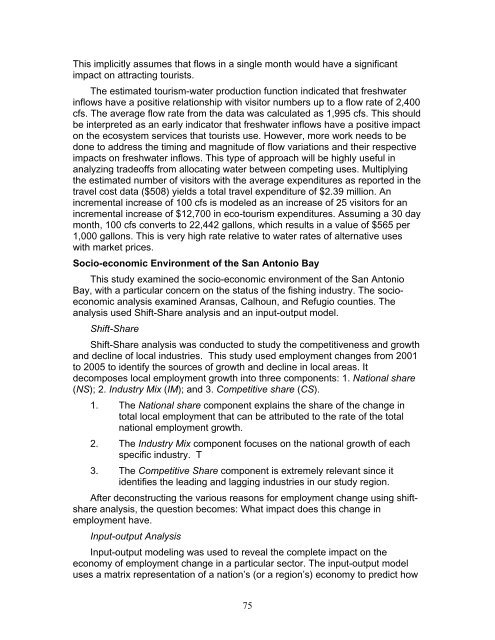The Economic Value of Water and Ecosystem Preservation
The Economic Value of Water and Ecosystem Preservation
The Economic Value of Water and Ecosystem Preservation
Create successful ePaper yourself
Turn your PDF publications into a flip-book with our unique Google optimized e-Paper software.
This implicitly assumes that flows in a single month would have a significant<br />
impact on attracting tourists.<br />
<strong>The</strong> estimated tourism-water production function indicated that freshwater<br />
inflows have a positive relationship with visitor numbers up to a flow rate <strong>of</strong> 2,400<br />
cfs. <strong>The</strong> average flow rate from the data was calculated as 1,995 cfs. This should<br />
be interpreted as an early indicator that freshwater inflows have a positive impact<br />
on the ecosystem services that tourists use. However, more work needs to be<br />
done to address the timing <strong>and</strong> magnitude <strong>of</strong> flow variations <strong>and</strong> their respective<br />
impacts on freshwater inflows. This type <strong>of</strong> approach will be highly useful in<br />
analyzing trade<strong>of</strong>fs from allocating water between competing uses. Multiplying<br />
the estimated number <strong>of</strong> visitors with the average expenditures as reported in the<br />
travel cost data ($508) yields a total travel expenditure <strong>of</strong> $2.39 million. An<br />
incremental increase <strong>of</strong> 100 cfs is modeled as an increase <strong>of</strong> 25 visitors for an<br />
incremental increase <strong>of</strong> $12,700 in eco-tourism expenditures. Assuming a 30 day<br />
month, 100 cfs converts to 22,442 gallons, which results in a value <strong>of</strong> $565 per<br />
1,000 gallons. This is very high rate relative to water rates <strong>of</strong> alternative uses<br />
with market prices.<br />
Socio-economic Environment <strong>of</strong> the San Antonio Bay<br />
This study examined the socio-economic environment <strong>of</strong> the San Antonio<br />
Bay, with a particular concern on the status <strong>of</strong> the fishing industry. <strong>The</strong> socioeconomic<br />
analysis examined Aransas, Calhoun, <strong>and</strong> Refugio counties. <strong>The</strong><br />
analysis used Shift-Share analysis <strong>and</strong> an input-output model.<br />
Shift-Share<br />
Shift-Share analysis was conducted to study the competitiveness <strong>and</strong> growth<br />
<strong>and</strong> decline <strong>of</strong> local industries. This study used employment changes from 2001<br />
to 2005 to identify the sources <strong>of</strong> growth <strong>and</strong> decline in local areas. It<br />
decomposes local employment growth into three components: 1. National share<br />
(NS); 2. Industry Mix (IM); <strong>and</strong> 3. Competitive share (CS).<br />
1. <strong>The</strong> National share component explains the share <strong>of</strong> the change in<br />
total local employment that can be attributed to the rate <strong>of</strong> the total<br />
national employment growth.<br />
2. <strong>The</strong> Industry Mix component focuses on the national growth <strong>of</strong> each<br />
specific industry. T<br />
3. <strong>The</strong> Competitive Share component is extremely relevant since it<br />
identifies the leading <strong>and</strong> lagging industries in our study region.<br />
After deconstructing the various reasons for employment change using shiftshare<br />
analysis, the question becomes: What impact does this change in<br />
employment have.<br />
Input-output Analysis<br />
Input-output modeling was used to reveal the complete impact on the<br />
economy <strong>of</strong> employment change in a particular sector. <strong>The</strong> input-output model<br />
uses a matrix representation <strong>of</strong> a nation’s (or a region’s) economy to predict how<br />
75
















